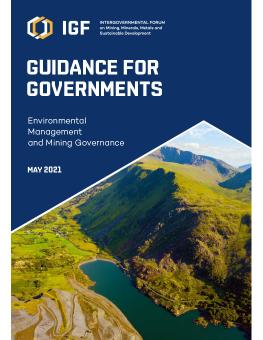
IGF Guidance for Governments: Environmental management and mining governance
This guidance highlights the key issues, benchmarks, and standards in four main areas of environmental management in mining—water, biodiversity, waste management, and emergency preparedness and response—and governments' role in ensuring that each is managed in support of sustainable development.
Mineable mineral deposits exist in both convenient and inconvenient locations. They can be remote or close to cities and towns, near water resources and sensitive ecosystems, and in areas prone to fierce storms or earthquakes. Governments can use environmental management throughout the mining life cycle to avoid or mitigate negative impacts and facilitate successful remediation. Conversely, a failure to effectively manage operations can threaten their continued viability and undermine the relationships between a mining company, affected communities, and all levels of government.
Effective environmental management is founded on legal frameworks, regulations, and policies that position governments for successful management throughout the mining life cycle.
To help governments in this regard, the IGF Secretariat’s Guidance for Governments: Environmental Management and Mining Governance:
- Summarizes international practices, highlighting universally applicable standards and practices to develop and implement legal frameworks, regulation, and policy
- Identifies important legislative, regulatory, and policy tools and mechanisms
- Outlines what governments must do before, during, and after mining.
Drawing on the IGF’s Mining Policy Framework (MPF), the guidance also highlights the key issues, benchmarks, and standards in four main areas of environmental management in mining—water, biodiversity, waste management, and emergency preparedness and response—and governments’ role in ensuring that each is managed in support of sustainable development.
Participating experts
You might also be interested in
2023 IGF Annual Report
Detailing an eventful year that saw the IGF Secretariat deliver several new publications, workshops, and events for its growing membership.
What Makes Minerals and Metals "Critical"?
Exploring how governments define what should be considered as "strategic" or "critical" based on a series of objective criteria.
Modernizing Artisanal and Small-Scale Mining
How will emerging technologies affect the artisanal and small-scale mining sector?
ASGM Tailings Management and Reprocessing Governance
This report outlines technical aspects, governance frameworks, and policy recommendations for artisanal and small-scale gold mining (ASGM) tailings management and reprocessing.